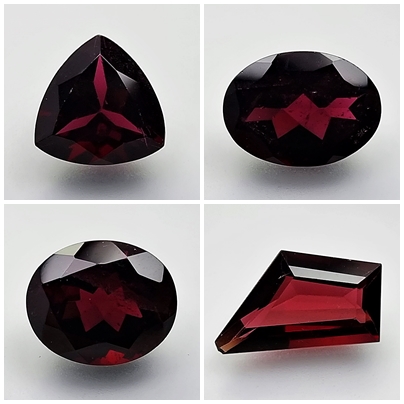Rhodolite Garnet: Gemstone Information
Rhodolite garnet, a captivating member of the garnet family, entices with its mesmerizing deep red hue, tinged with hints of purple. This gemstone, prized for its beauty and rarity, holds a fascinating history and boasts a range of captivating attributes.
Origin and Formation:
Rhodolite garnet derives its name from the Greek word “rhodon,” meaning “rose-like,” due to its vibrant pinkish-red color. It forms through a combination of minerals, primarily almandine and pyrope garnet, resulting in its unique coloration. This gemstone typically occurs in metamorphic rocks, often found in regions such as Sri Lanka, Brazil, Zimbabwe, and the United States, among others.
Characteristics:
One of the distinguishing features of rhodolite garnet is its exceptional brilliance and clarity. Its vibrant coloration ranges from deep red to purplish-red, depending on the light conditions and the specific mineral composition. Rhodolite garnet often exhibits high transparency, allowing light to pass through and enhancing its allure. The gemstone’s hardness, ranking around 7 to 7.5 on the Mohs scale, signifies its durability, suitable for various jewelry applications.
Color Variations:
While rhodolite garnet predominantly showcases a rich red hue with purple undertones, its coloration can vary subtly depending on its origin and specific mineral composition. Some specimens may lean more towards a raspberry-red shade, while others may exhibit a deeper crimson tone. The interplay of light and the gemstone’s internal structure contribute to its multifaceted appearance, making each piece unique.
Historical Significance:
Throughout history, garnets have held significant cultural and symbolic value. In ancient times, they were believed to possess protective properties and were often worn as talismans by warriors for courage and strength. Garnets were also favored by royalty and nobility for their perceived associations with wealth and power. While rhodolite garnet’s specific historical significance may not be as prominent as other gemstones, its allure and beauty have undoubtedly captured the admiration of civilizations throughout the ages.
Uses and Applications:
Rhodolite garnet’s enchanting beauty makes it a popular choice for various jewelry pieces. Whether set in rings, earrings, pendants, or bracelets, this gemstone adds a touch of sophistication and elegance to any design. Jewelry artisans appreciate its versatility, as it complements both contemporary and traditional styles. Additionally, rhodolite garnet’s durability makes it suitable for everyday wear, ensuring longevity and enjoyment for its wearer.
Market Value:
The market value of rhodolite garnet is influenced by several factors, including its color, clarity, cut, and carat weight. Fine-quality specimens with vivid red hues and excellent clarity command higher prices, especially those with minimal inclusions or imperfections. Larger stones are relatively rare and thus tend to be more valuable. However, smaller, well-cut rhodolite garnets can also be highly prized for their brilliance and color saturation.
Caring for Rhodolite Garnet:
To maintain the beauty and luster of rhodolite garnet jewelry, it’s essential to handle it with care and avoid exposure to harsh chemicals or abrasive materials. Regular cleaning with a soft brush and mild soapy water can help remove dirt and debris, restoring its natural brilliance. Additionally, storing rhodolite garnet jewelry separately from other gemstones can prevent scratches and damage.
In conclusion, rhodolite garnet stands as a testament to nature’s artistry, captivating admirers with its radiant color and inherent beauty. Whether cherished for its historical significance, admired for its rarity, or cherished as a symbol of love and affection, this exquisite gemstone continues to captivate hearts around the world.





